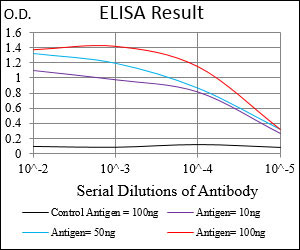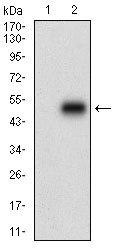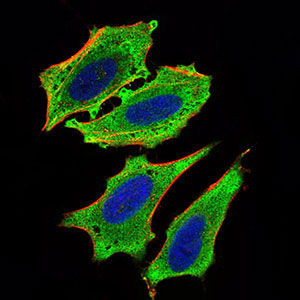MLXIPL Antibody
Purified Mouse Monoclonal Antibody
- 产品详情
- 实验流程
- 背景知识
Application
| WB, ICC, E |
|---|---|
| Primary Accession | Q9NP71 |
| Reactivity | Human |
| Host | Mouse |
| Clonality | Monoclonal |
| Clone Names | 5D12D1 |
| Isotype | IgG1 |
| Calculated MW | 93073 Da |
| Description | This gene encodes a basic helix-loop-helix leucine zipper transcription factor of the Myc/Max/Mad superfamily. This protein forms a heterodimeric complex and binds and activates, in a glucose-dependent manner, carbohydrate response element (ChoRE) motifs in the promoters of triglyceride synthesis genes. The gene is deleted in Williams-Beuren syndrome, a multisystem developmental disorder caused by the deletion of contiguous genes at chromosome 7q11.23. |
| Immunogen | Purified recombinant fragment of human MLXIPL (AA: 18-143) expressed in E. Coli. |
| Formulation | Ascitic fluid containing 0.03% sodium azide. |
| Gene ID | 51085 |
|---|---|
| Other Names | Carbohydrate-responsive element-binding protein, ChREBP, Class D basic helix-loop-helix protein 14, bHLHd14, MLX interactor, MLX-interacting protein-like, WS basic-helix-loop-helix leucine zipper protein, WS-bHLH, Williams-Beuren syndrome chromosomal region 14 protein, MLXIPL, BHLHD14, MIO, WBSCR14 |
| Dilution | WB~~1/500 - 1/2000 ICC~~N/A E~~1/10000 |
| Storage | Maintain refrigerated at 2-8°C for up to 6 months. For long term storage store at -20°C in small aliquots to prevent freeze-thaw cycles. |
| Precautions | MLXIPL Antibody is for research use only and not for use in diagnostic or therapeutic procedures. |
| Name | MLXIPL |
|---|---|
| Synonyms | BHLHD14, MIO, WBSCR14 |
| Function | Binds DNA as a heterodimer with MLX/TCFL4 and activates transcription. Binds to the canonical E box sequence 5'-CACGTG-3'. Plays a role in transcriptional activation of glycolytic target genes. Involved in glucose-responsive gene regulation (By similarity). Regulates transcription in response to changes in cellular carbohydrate abundance such as occurs during fasting to feeding metabolic transition. Refeeding stimulates MLXIPL/ChREBP transcription factor, leading to increased BCKDK to PPM1K expression ratio, phosphorylation and activation of ACLY that ultimately results in the generation of malonyl-CoA and oxaloacetate immediate substrates of de novo lipogenesis and gluconeogenesis, respectively (By similarity). |
| Cellular Location | Nucleus. |
| Tissue Location | Expressed in liver, heart, kidney, cerebellum and intestinal tissues |
For Research Use Only. Not For Use In Diagnostic Procedures.
Provided below are standard protocols that you may find useful for product applications.
BACKGROUND
This gene encodes a common acute lymphocytic leukemia antigen that is an important cell surface marker in the diagnosis of human acute lymphocytic leukemia (ALL). This protein is present on leukemic cells of pre-B phenotype, which represent 85% of cases of ALL. This protein is not restricted to leukemic cells, however, and is found on a variety of normal tissues. It is a glycoprotein that is particularly abundant in kidney, where it is present on the brush border of proximal tubules and on glomerular epithelium. The protein is a neutral endopeptidase that cleaves peptides at the amino side of hydrophobic residues and inactivates several peptide hormones including glucagon, enkephalins, substance P, neurotensin, oxytocin, and bradykinin. This gene, which encodes a 100-kD type II transmembrane glycoprotein, exists in a single copy of greater than 45 kb. The 5' untranslated region of this gene is alternatively spliced, resulting in four separate mRNA transcripts. The coding region is not affected by alternative splicing. ;
REFERENCES
1. Diabetes. 2012 Mar;61(3):574-85. 2. Biochim Biophys Acta. 2011 Dec;1811(12):1194-200.
终于等到您。ABCEPTA(百远生物)抗体产品。
点击下方“我要评价 ”按钮提交您的反馈信息,您的反馈和评价是我们最宝贵的财富之一,
我们将在1-3个工作日内处理您的反馈信息。
如有疑问,联系:0512-88856768 tech-china@abcepta.com.























 癌症的基本特征包括细胞增殖、血管生成、迁移、凋亡逃避机制和细胞永生等。找到癌症发生过程中这些通路的关键标记物和对应的抗体用于检测至关重要。
癌症的基本特征包括细胞增殖、血管生成、迁移、凋亡逃避机制和细胞永生等。找到癌症发生过程中这些通路的关键标记物和对应的抗体用于检测至关重要。 为您推荐一个泛素化位点预测神器——泛素化分析工具,可以为您的蛋白的泛素化位点作出预测和评分。
为您推荐一个泛素化位点预测神器——泛素化分析工具,可以为您的蛋白的泛素化位点作出预测和评分。 细胞自噬受体图形绘图工具为你的蛋白的细胞受体结合位点作出预测和评分,识别结合到自噬通路中的蛋白是非常重要的,便于让我们理解自噬在正常生理、病理过程中的作用,如发育、细胞分化、神经退化性疾病、压力条件下、感染和癌症。
细胞自噬受体图形绘图工具为你的蛋白的细胞受体结合位点作出预测和评分,识别结合到自噬通路中的蛋白是非常重要的,便于让我们理解自噬在正常生理、病理过程中的作用,如发育、细胞分化、神经退化性疾病、压力条件下、感染和癌症。









